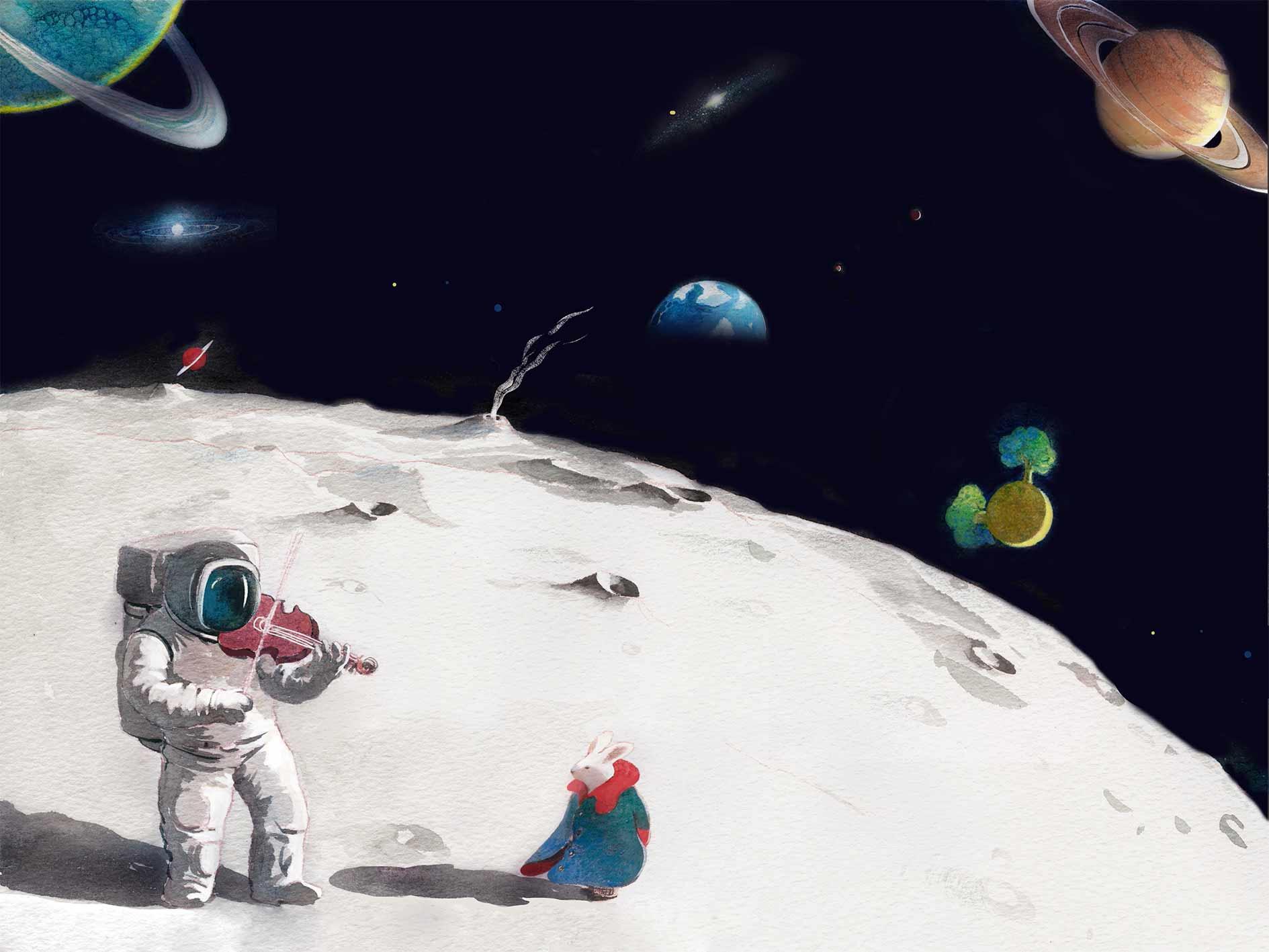A panoramic interpretation of the current state, development trends, and potential of the DAO ecosystem
This article was published on Beep Coin, original title: "DAO Can Be, Very DAO", author: Mia Bao
The Past and Present of DAO
On April 30, 2016, the blockchain company Slock.it initiated the first DAO project—The DAO, which was an early decentralized autonomous organization (DAO) and venture capital fund. At that time, 11,000 people invested 11.5 million ETH, accounting for 14% of the total supply of Ethereum, worth about $150 million. This made The DAO the largest crowdfunding project at that time, with a level of FOMO that exceeded many people's imaginations, including that of the project team itself.
"The DAO represents a paradigm shift in the concept of economic organizations. It offers complete transparency, total shareholder control, unprecedented flexibility, and self-governance."
However, joy turned to sorrow. "Pause trading, we are under attack." On June 17, 2016, hackers exploited two vulnerabilities in The DAO—"reentrancy" and "call transfer to avoid destruction"—to carry out over two hundred attacks, stealing a total of 3.6 million Ethereum, which was more than one-third of the total amount raised by the project.
However, the hackers could not directly cash out; according to the smart contract terms at that time, these funds would be frozen for 28 days, giving The DAO and the Ethereum community nearly a month to consider how to handle the situation. As we all know, the Ethereum community executed a hard fork, splitting into ETC and ETH, in order to salvage the losses. The Ethereum core team could not force the community to move, but people voted with their feet, answering the question: Did eliminating the hacker's benefits outweigh the cost of human intervention on Ethereum's trust? For most people, indeed it did.
If it weren't for the fork, the Ethereum stolen by hackers from The DAO on June 17, 2016, would today be worth $6.6 billion.
Five years later, discussions about DAO have resurfaced, and DAO now has a series of use cases. I can see some very smart friends around me starting to discuss DAO, and the current native state of DAO feels a bit like NFTs at the beginning of 2020.
When we were early in the NFT space, we thought it was "the closest entry point for blockchain to reality," and the facts proved that it indeed attracted a lot of attention: in just three days, Meebits had a total trading volume of 12,000 ETH in the secondary market, approximately $42 million; a pair of socks on Uniswap sold for $160,000; a five-word tweet from Jack Dorsey was auctioned for $2.5 million; the first work of Nyan Cat sold for $656,000; and Beeple's NFT work at Christie's sold for a staggering $69.35 million…
But today's DAO seems much more obscure and difficult to understand. So what exactly is DAO?
What is DAO?
Kevin Kelly described the behavior of swarms in "Out of Control": When a group of bees wants to move, the queen does not make the decision directly; instead, a group of bees goes out to scout, and upon returning, the scout bees dance to indicate the results. The more exaggerated the dance, the better the location. The swarm then sends more bees to check it out. If they also find it good, they will return and dance together. "Through this repeated emphasis, the favored location attracts more visitors, leading to even more visitors joining in."
In the end, the largest swarm wins, and the queen migrates accordingly. In this process, the queen does nothing but follow the largest swarm; no bee makes the "final decision," yet almost all bees participate in the decision.
This is swarm intelligence, "The magic of 'swarm intelligence' is that no single bee controls it, but there is an invisible hand, a hand that emerges from a large number of dull members, controlling the entire group."
This is the essence of a native DAO.
Examining the definition of DAO, a DAO (Decentralized Autonomous Organization) is a decentralized autonomous organization that is a group organized around a task, coordinating self-governance through a set of shared rules executed on the blockchain.
DAO delegates decision-making power to stakeholders rather than executives or board members to achieve "decentralization"; "autonomy" is realized through smart contracts, allowing applications running on a publicly accessible blockchain to automatically trigger relevant actions and outcomes if certain conditions are met.
This represents a transformation and update in "organizational form."
I really like Jesse Walden's previous summary of DeFi and NFT:
- DeFi: Money Legos
- NFT: Media Legos
I believe DAO may be the upper layer of NFT; DAO can own NFTs and create NFTs, and can also accommodate many non-NFT matters. If NFTs are "Media Legos," then DAO is likely "Corporate Legos," which aligns with Santi's viewpoint.
"Just like today's creator fan communities, each 'company' or project will become more like a tribe, driven and defined by the stories and symbols that connect its members, led by those who can weave its narrative best."
Although DAO is a process of "decentralization," it must not lack a "power center." The criticism that a project or organization is ultimately controlled by a small group of people is not a flaw of DAO. Any organization that wants to carry out decisions and tasks in an orderly manner must have decision-makers, whether in the early or later stages, whether tangible or intangible, whether collective or individual. What DAO aims to solve is the "dispersibility" and "fluidity" of power; the former empowers project participants with a voice in the project, while the latter ensures the continuous turnover of decisive leaders.
In my previous article "Post-NFT Era," I mentioned the Social Money effect. If Social Money promotes the process of "monetization" of individual influence, then DAO is about the grand proposition of how much we can accomplish together.
The Organizational Form of DAO
As of early May, the total assets managed by the DAO ecosystem (according to DeepDAO data) have surpassed $1 billion, and this figure does not include those crypto protocols that do not operate in DAO form or use independent DAO structures. "The total assets managed by the DAO ecosystem" is similar in meaning to "the asset scale managed by corporate governance" in a market economy, but since the vast majority of assets in a market economy are managed by companies, direct comparisons of scale are not convenient. However, as a new type of organizational governance model, the scale of "$1 billion" is sufficient to become a marker of the development of the DAO ecosystem itself.

Ranking of total assets managed by DAO
Olaf Carlson-Wee, CEO and founder of Polychain Capital, previously stated: "DAO is the future of venture capital, and DAO is about to become the second major breakthrough in the blockchain space after digital cash."
Of course, the classification of DAO here may be too "narrow," as not all DAO ecosystems are related to "asset management." The organizational forms of DAO can also be categorized into eight types: "Infrastructure," "Asset Management Type DAO," "Governance DAO," "Aggregator," "Yield DAO," "Guild," "Creator & Media DAO," and "DAO Adaptor."
At the infrastructure level, DAO has gradually become an important component of the Web3 infrastructure. The continuous development of various DAO protocols like Aragon, DAOstack, and Moloch provides great convenience for organizations that want to initiate, govern, and manage DAOs. For example, Aragon offers a one-stop tool and service to turn communities, businesses, and more into an economy, unleashing a long-tail DAO organizational form. In contrast to Aragon's complexity, Moloch is built with a "brutal minimalism" design philosophy, aiming to create a "minimum viable DAO" that allows people to allocate shared resources for a common goal while actively minimizing the impact of negative factors.
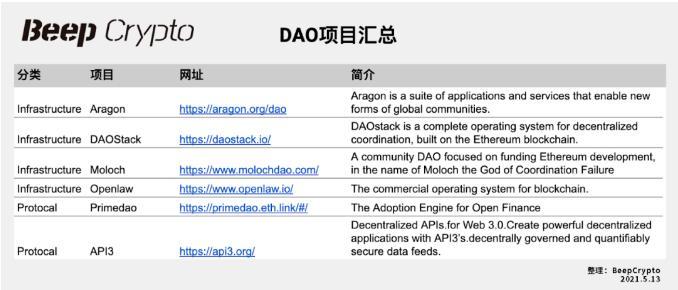
In the asset management category, it currently occupies a significant share of the DAO market, namely Venture DAO, which refers to "investment-oriented" DAO organizations, such as Metacartel, The LAO, etc. There are also investment organizations that issue "Grants," such as Moloch, Marketing DAO, etc.
Venture DAO differs from traditional funds in that institutions and high-net-worth individuals (limited partners or LPs) invest funds into the fund, while others (general partners or GPs) invest funds into companies. DAO investors will be able to vote on proposals based on pre-set rules in the smart contract. Each person's vote is weighted by the number of tokens they hold, which is based on their investment amount. If a proposed project receives enough votes, the smart contract will automatically trigger The DAO's funds to be invested into the project's ETH wallet. Of course, this is the ideal form of Venture DAO; many DAOs are still in a "gradual decentralization" state (see the next chapter for details).
It is worth mentioning that Venture DAO has shown remarkable performance in the NFT space. The DAO organizations listed below, such as WHALE, FlamingoDAO, PleasrDAO, and Jenny Metaverse DAO, are all focused on investing in NFT assets. On April 19, PleasrDAO successfully auctioned Snowden's first NFT work "Stay Free" for 2,224 ETH, defeating competitors. Jenny Metaverse DAO also recently completed a fundraising of $7 million, while WHALE founder WhaleShark repeatedly stated that the core philosophy of WHALE is "WhaleShark out, DAO up!" All of this seems to gradually validate Matt Huang's statement: "The next Berkshire Hathaway will begin as a DAO."
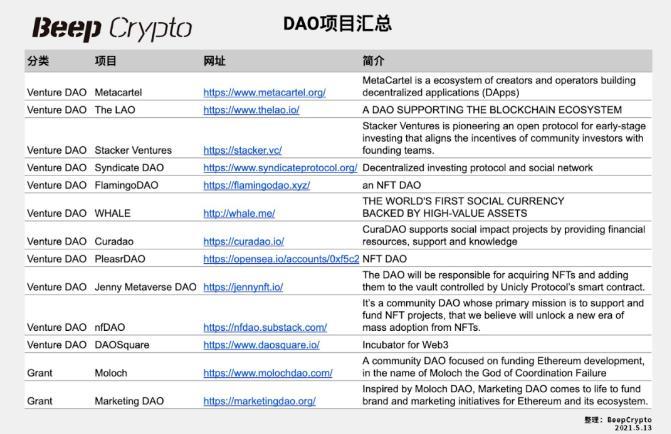
Governance-type DAOs are an extremely important component, aside from investment-type DAOs. As mentioned earlier, DAO is a process of "decentralizing power." Users determine voting weight based on the proportion of assets they hold, and voting weight directly influences the direction of decisions (the decision-making process of DAO will be discussed in detail in the next chapter "Believability Weighting and Radical Transparency"). This decision is implemented through governance tools such as Snapshot, Tally, Gnosis SAFE, etc. Of course, a project may have multiple attributes and labels; for example, Aragon is not only an infrastructure but also a governance tool. DAOs in the "Aggregator" category often also have voting governance functions.
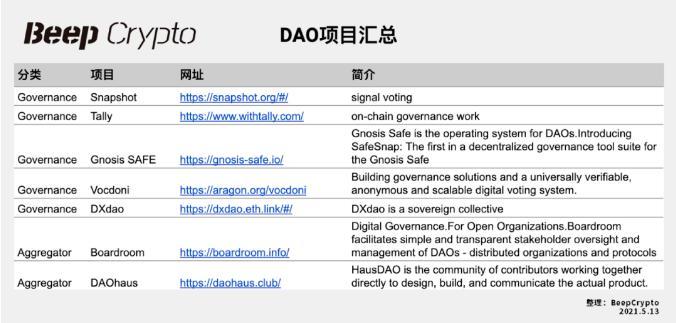
As for the later organizational forms, Yield DAO is a category that gathers assets to collaboratively earn DeFi yields, with Barn DAO, PieDAO, BadgerDAO, etc., consistently ranking among the top in DAO asset accumulation.
Guild DAO is akin to a guild governance model, such as Yield Guild Games (YGG), which is a gaming guild where players from various locations can come together to earn game rewards through various play-to-earn mechanisms. In traditional blockchain games, especially NFT games, users often need to hold NFT assets to enter the game, while guild organizations like YGG can help users bypass the asset purchase process, achieving a win-win situation by separating asset ownership from usage rights. Raid Guild and Rabbithole are similar to "task outsourcing" organizations; the former gathers blockchain professionals to provide services such as "consulting," "public relations," "design," and "development," while the latter targets end-users, allowing them to earn rewards by completing tasks like playing dapps. Metafactory is a business-oriented DAO focused on incubating digital and physical fashion brands.
Creator DAO and Media DAO are newly emerging DAO organizations. Since the millennial generation has become the main force in society, the Passion Economy and Creator Economy have gradually risen. From a capital perspective, there is a trend from VC to Community Capital to Solo Capital, which are all results of the fermentation of "individual influence." New creator communities like Mirrior minimize modules but maximize individual influence, radiating from personal influence to NFTs (products) or to Crowdfund (fundraising), which I believe is also a very avant-garde exploration.
In summary, essentially, any autonomous organization with DAO governance and management can be called a DAO. Therefore, DAO is more like a "composable module" that permeates various projects. This type of ecological composition is defined here as "DAO Adaptor," with well-known projects including Uniswap, MakerDAO, AAVE, Compound, YFI, Aavegotchi, Decentraland, etc., all pioneers of DAO organizations.
DAO is not a top-down hierarchical structure but rather uses Web3 technology and rapidly evolving governance and incentive systems to allocate decision-making power and financial rewards. The various organizational forms mentioned above may be overly complex; I believe that simply put, aside from the infrastructure category, DAO is actually a new combinatorial way to finance projects (Venture DAO), govern communities (Governance DAO), and share value (Creator DAO).
Gradual Decentralization
When I researched NFT, DAO, Social Token, Passion Economy, and Creator Economy, I often observed the viewpoints of NotBoring's Packy McCormick and Variant Fund's Jesse Walden. When I first read Packy's article, my exact words to my friend were, "Shit, he is literally reading my mind…" It is no exaggeration to say that he is a treasure blogger I want to keep to myself, while Jesse's articles provide me with more divergent inspiration (both are highly recommended). "Gradual decentralization" is a concept proposed by Jesse Walden, who believes: "Cryptocurrency companies do not have to, and generally should not, become a DAO from day one; they can evolve continuously."
Being overly rigid about the original form of things often prevents one from truly understanding the essence of things. Whether it is packaging or categorizing, "definitions" serve to "better articulate the product itself," rather than to restrict "the product itself." The same goes for DAO.
Transitioning from centralization to decentralization hinges on whether the innovation contributes to the product itself and whether the current stage of the product is suitable for such innovation. Only if both answers are yes is there a necessity to proceed. During the entrepreneurial journey, continuously testing and communicating with users through demos forms a good feedback loop, which is essential for continuously improving the product itself. A good product requires experimentation and feedback, not just a founder sitting at home watching "Out of Control," predicting the strategic landscape for the next 50 years, and then talking about it on paper. A good product must be closely linked to its environment and evolve together.
So how can we gradually complete a decentralized governance framework to "establish a sustainable, compliant, and community-owned product"?
Walden provided us with three steps, and I think it is necessary for everyone to discuss them together:
Product-Market Fit
The early stage of a cryptocurrency startup should look like the early stage of any startup: a small, focused team dedicating all their energy to building, learning, and iterating until they find a product that fits the market. If the product is poor, it will ultimately detach from the community. Web3 startups have a significant advantage here; by integrating existing smart contracts, code, and products into new contracts, they can quickly build and test, completing a rapid trial-and-error process. DeFi is called "Money Legos" because whenever someone builds something new, it can immediately become a module available for others to use. The magic of creation lies not only in creating Legos but also in reconstructing the combinations of Legos.
Aavegotchi is one of the teams I have encountered that pays the most attention to DAO-ification. From proposals to voting, to mapping social networks like Discord/Twitter to project contribution weight, they are all practicing DAO-ification. However, it also cannot escape the process of "gradual DAO-ification": the initial positioning is determined by the team, while later major decisions are made by the community. I vividly remember that after the first portal sale, when the community voted to delay the second portal sale on Snapshot, even the team was surprised by the result that "there would be no second portal before the first rarity mining." But shouldn't the birth of a good product be determined by the "market"?
Community Participation
Once a company achieves product-market fit, it should begin to encourage more stakeholders to participate directly. Walden likens this to "open-source development," inviting community participation, offering bounties, grants, and other incentives, developing in an open environment, building a community, and reaching preliminary consensus on decisions.
In this regard, the domestic team I admire the most is Conflux. Although they have not yet transitioned to complete decentralization, they have already systematized their "original task outsourcing." Their Bounty program solicits talented individuals from the open community across several dimensions, including "technology," "branding," "community," "resources," and "others." Each task is clearly listed, and relevant individuals can directly claim them, allowing more stakeholders to participate in building the ecosystem.
The voxel creator community of The Sandbox is also a "native DAO." Artists periodically form several groups based on relevant themes, and each group designates corresponding group leaders based on the weight of previous works. The group leaders guide members and ensure the steady progress of the creative process; everything has rules, but the power is "fluid."
The above examples are consistent with the Guild category in our initial classification of DAO. However, due to the gradual process of DAO, projects still operate in a "primitive-like" manner. If they transition to complete DAO governance in later stages, scalability will grow exponentially.
Sufficient Decentralization of Power
After completing the first two steps, the next step is to "complete DAO decision-making and execute automatically." Breaking it down, we need to focus on two aspects: Voting power and automatic execution. Voting power is currently mostly determined by the number of tokens held, but many people criticize that core teams or whales may influence decisions based on their status in the community or the number of tokens they hold. We will discuss the issues and solutions regarding this in detail in the next chapter. Automatic execution involves minting and distributing tokens by triggering pre-set rules in smart contracts, which determine how much each person receives today and how tokens will be distributed in the future.
In this way, the future development of the project is in the hands of the community, which is also the key reason many projects currently need "gradual decentralization." Earlier, when I asked WhaleShark about why WHALE's DAO proposal was still initiated on Discord rather than deployed on any DAO infrastructure, his answer was that current DAO proposals are not yet perfect, and many DAO proposals are complex. Currently, there is no product that allows proposals to be executed automatically without manual intervention. Voting power also has many of the issues mentioned above.
A loyal community combined with effective governance will effectively promote the product and market to achieve a perfect fit, and this may be the most effective way to complete DAO innovation.
Believability Weighting and Radical Transparency
In the previous chapter, a question was left: "Currently, most DAO governance is determined by the number of tokens held, which can easily lead to concentration of control by large holders or a small number of people." Some refer to the "one person, one vote" decision-making method as "single-cell democracy," which is pseudo-democracy. Pursuing absolute democracy for individuals is not necessarily the optimal solution for decision-making. So how can we ensure a balance between democracy and autocracy while maintaining a Nash equilibrium in strategy?
"My goal is to do meaningful work with the people I work with and build meaningful relationships. I know that only extreme transparency and algorithmic decision-making mechanisms can help me achieve this goal." ---Ray Dalio
Believability weighting and radical transparency come from Bridgewater's decision-making model. Although Dalio is not a big fan of Bitcoin, Bridgewater's corporate decision-making model is unexpectedly very DAO-like.
In DAO decision-making, I often hear the most opposition to the idea that "a group of people cannot make decisions." Besides the "stake" represented by tokens, what other "dimensions" can be used for weighting? Or does a larger number of people mean absolute correctness? Do large holders/whales represent absolute correctness? The answer is clearly negative. So can we improve this by following the idea of "believability weighting"?
Believability weighting, simply put, means that if a person is credible, their opinions carry more weight; if a person is not credible, their opinions carry less weight. This principle seems simple, but implementing it is not easy, which is why Bridgewater's governance is often referred to as "cult culture."
"Dot Collector" is the tool Bridgewater uses to implement believability weighting. Employees can score others based on different dimensions such as strategic thinking and dealing with ambiguity, with scores ranging from 1 to 10, where 7 is the average level.
All feedback, including the scorer's ID, score, and additional comments, is permanently saved. Each feedback is called a dot, and a person may be covered in dots; for example, Bridgewater's co-CIO has about 11,000 dots. Each dimension ultimately contributes to a person's "believability." In the decision-making process, we can weight decisions based on believability.
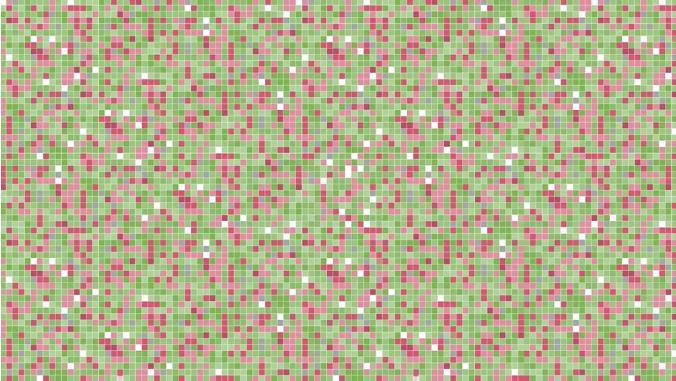
Each person's weighted image based on believability
"Creative selection = extreme truth-seeking + extreme transparency + credible weighting decision-making."
Returning to our DAO governance, taking Venture DAO as an example, the simplest "believability weighting" method is to track each investment decision made by investors to form their "investment credibility," which will then create different weights in the next investment (this part, if derived, will need to expand into discussions about DID).
This is the "idea meritocracy" advocated by Bridgewater, achieving the best decision-making through believability weighting to pursue "radical transparency."
Of course, the success of DAO decision-making is not solely dependent on "believability weighting." Charlene Li, in her book "Open Leadership," explains the characteristics and implementation methods of open communication within enterprises through six aspects: explaining, updating, conversing, open mic, crowdsourcing, and unified information platforms. I believe these also have reference significance (the chapter's issues will not be elaborated on further).
The process of transitioning from a corporation to a DAO organization is a continuous process of opening up from closed specialized dimensions.
The Present of NFT and the Future of DAO
Just like NFTs, the early experiments of DAO may only represent a small part of its future potential. With the emergence of more DAO tools, attempts at innovation are becoming increasingly easier, and DAO Legos are continuously being filled in, not only at the application layer but also in regulatory progress.
In April of this year, the Wyoming State Legislature passed the Vermont Bill for blockchain legislation, which approved the legality of DAOs, allowing them to be established as limited liability companies. For DAOs, this could be a significant step forward, as the bill will allow DAOs to operate on-chain, act as asset agents, and manage their affairs, undoubtedly paving the way for the scalability of DAOs.
After entering the DAO rabbit hole, I have been looking forward to seeing what interesting ideas exist in this field and how the aforementioned incentive models can feed back into the projects themselves.
"The next big thing will start out looking like a toy." I believe that the present of NFTs will be the future of DAOs.
Thanks to Alex Yung and Summer Zhao for proofreading this article.
References:
https://letstalkbitcoin.com/is-bitcoin-overpaying-for-false-security#.UjtiUt9xy0w
https://variant.fund/the-ownership-economy-the-next-frontier-for-community-driven-software/
https://linda.mirror.xyz/Vh8K4leCGEO06_qSGx-vS5lvgUqhqkCz9ut81WwCP2o
https://blog.csdn.net/qq_35624642/article/details/78138081
https://variant.fund/leadership-in-the-ownership-economy/
https://onlinelibrary.wiley.com/doi/full/10.1111/j.1468-0335.1937.tb00002.x
https://messari.io/article/q1-2021-web3-review-nfts-metaverses-and-daos
https://cointelegraph.com/ethereum-for-beginners/what-is-dao
https://a16z.com/2019/03/02/cooperatives-cryptonetworks/
https://www.coindesk.com/nfts-daos-new-creator-economy
https://www.odaily.com/post/5163726
https://darkstar.mirror.xyz/Tf9IS6yNxtPXwC5mmfi_UISe8v6BOfef2bDmQSxoJao
https://boardroom.mirror.xyz/N0kJ-y_5wvPR0H1MMNFb531MOKEE4LKWxepzQLj18sw
https://medium.com/abridged-io/the-spectrum-of-decentralization-124c8ea6d045
https://medium.com/primedao/conceptual-models-for-dao2dao-relations-ac2b2d3cc84d
https://a16z.com/2019/10/08/passion-economy/
https://gardens.substack.com/p/daos-and-the-pitfalls-of-progressive
https://www.landsburg.com/grothendieck/mclarty1.pdf
https://www.businessinsider.com/bridgewater-ray-dalio-radical-transparency-app-dots-2017-9



